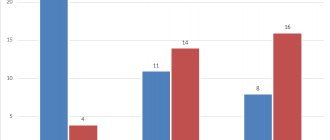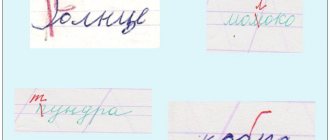I Sadovnikova - Impairments in written speech and their overcoming in younger schoolchildren
1 …
Sadovnikova I.N.
Disorders of written speech and their overcoming in primary schoolchildren
Preface
The problem of impaired writing in schoolchildren is one of the most pressing for school education, since writing and reading from the purpose of primary education turn into a means of further acquisition of knowledge by students.
The book reflects the results of many years of scientific and practical activity of the author, developing the problem of writing and reading disorders in relation to the population of students in secondary schools and, mainly, primary classes, because the main task of a school speech therapist is to promptly identify and overcome disorders of written speech, preventing their transition, complicating the educational and cognitive activity of students, to subsequent stages of education.
The first section of the book covers the prerequisites for the formation of writing and reading normally and the mechanisms of disorders leading to persistent specific errors in written speech; The revealed typology of such errors is illustrated by examples from student works. An original system for identifying and recording specific writing errors by a speech therapist is presented. The criteria for distinguishing dysgraphia from immaturity of writing skills, characteristic of the stage of literacy acquisition, are described. Diagnostic tasks are proposed to identify dysgraphia in students in grades 1–3. Materials from a comprehensive study of schoolchildren with dysgraphia are presented, characterizing the state of a number of their sensorimotor and gnostic functions that are important for the development of written speech.
The second section reveals a system of correctional education to overcome written language disorders - in four main areas. Each chapter is preceded by the necessary methodological commentary, defining the tasks and methods of organizing the proposed types of work. The range of topics, content and forms of work are determined by the specifics of speech therapy tasks, but at the same time they correlate with the key issues of the Russian language program in primary school.
Classes to overcome dysgraphia should not turn into an endless process of writing or rewriting. It is necessary to provide varied speech practice for students - to develop language ability and observation, to develop speech communication skills. For these purposes, a sufficient amount of various exercises is offered, most of which are performed orally with a clearly organized system of feedback signals (cards, symbols, numbers, actions with a ball and clapping, etc.), i.e. To some extent, we can say that we form writing operations without a notebook and pen. Entertaining speech material should also help relieve tension and fear of writing in children who feel their own inadequacy in grapho-lexical activity, and create a positive emotional mood in children during group classes.
The book is addressed to a wide range of people:
§ speech therapists of general education and special schools of various types;
§ primary school teachers and Russian language teachers;
§ students of defectology faculties;
§ speech therapists of preschool institutions (to ensure continuity in correctional work);
§ practical psychologists of school institutions;
§ parents of children who have difficulties mastering writing and reading, to organize systematic homework.
SECTION I. VIOLATIONS OF WRITTEN SPEECH
Chapter I. WRITTEN SPEECH AND PREREQUISITES FOR ITS FORMATION
§1. WRITTEN SPEECH
Written speech is one of the forms of language existence, opposed to oral speech. This is a secondary, later in time form of the existence of language. For various forms of linguistic activity, both oral and written speech can be primary (compare folklore and fiction). If oral speech separated man from the animal world, then writing should be considered the greatest of all inventions created by mankind. Written speech not only revolutionized the methods of accumulating, transmitting and processing information, but it changed man himself, especially his ability to think abstractly.
The concept of written speech includes reading and writing as equal components. “Writing is a symbolic system for recording speech, which allows, with the help of graphic elements, to transmit information at a distance and consolidate it in time. Any writing system is characterized by a constant composition of characters" (FOOTNOTE Russian language: Encyclopedia. M., 1979. P. 205)
Russian writing refers to alphabetic writing systems. The alphabet marked the transition to symbols of higher orders and determined progress in the development of abstract thinking, making it possible to make speech and thinking objects of knowledge. “Only writing allows one to go beyond the limited spatial and temporal framework of speech communication, as well as preserve the impact of speech even in the absence of one of the partners. This is how the historical dimension of social self-awareness arises" (FOOTNOTE: Granovskaya PM Elements of Practical Psychology L., 1984. P. 182)
Both oral and written forms of speech are a type of temporary connections of the second signaling system, but, unlike oral, written speech is formed only under conditions of purposeful learning, i.e. its mechanisms develop during the period of learning to read and write and are improved during all further education. As a result of reflex repetition, a dynamic stereotype of a word is formed in the unity of acoustic, optical and kinesthetic stimulation (L. S. Vygotsky, B. G. Ananyev). Mastering written language is the establishment of new connections between the audible and spoken word, the visible and written word, because The writing process is ensured by the coordinated work of four analyzers: speech-motor, speech-auditory, visual and motor.
The shortest unit of speech, in accordance with this, can be conventionally represented by a trace. way:
Motor A. R. Luria defined reading as a special form of impressive speech, and writing as a special form of expressive speech, noting that writing (in any of its forms) begins with a specific plan, the preservation of which helps to inhibit all extraneous tendencies (running ahead, repetitions). and so on.). The letter itself includes a number of special operations:
§ analysis of the sound composition of the word to be recorded.
The first condition of writing is determining the sequence of sounds in a word.
The second is clarification of sounds, i.e. transformation of sound variants heard at the moment into clear generalized speech sounds - phonemes. At first, both of these processes occur completely consciously; later they become automated. Acoustic analysis and synthesis proceed with the closest participation of articulation;
§ translation of phonemes (audible sounds) into graphemes, i.e. into visual schemes of graphic signs, taking into account the spatial arrangement of their elements;
§ “recoding” of visual patterns of letters into a kinetic system of sequential movements necessary for writing (graphemes are translated into kinemes).
Recoding is carried out in the tertiary zones of the cerebral cortex (parieto-temporo-occipital region). Morphologically, the tertiary zones are finally formed in the 10th–11th year of life. The motivational level of writing is provided by the frontal lobes of the cerebral cortex. Their inclusion in a functional writing system ensures the creation of an idea that is retained through internal speech.
Retention of information in memory is ensured by the integral activity of the brain. As A. R. Luria notes, “the proportion of each writing operation does not remain constant at different stages of motor skill development. At the first stages, the writer’s main attention is directed to the sound analysis of the word, and sometimes to the search for the desired grapheme. In the established writing skill, these moments recede into the background. When writing well-automated words, writing turns into smooth, kinetic stereotypes.” (FOOTNOTE: Luria A.R. Higher cortical functions of humans and their disturbances in local brain lesions. M., 1962. P. 64)
Let us briefly consider the range of issues that allows us to trace the influence of a number of ontogenetic factors on the formation of written speech, namely: the formation of the mechanisms of oral speech and the evolution of spatial discrimination in a normally developing child.
The first set of questions is related to the fact that written speech uses ready-made mechanisms of oral speech.
1 …
Dysgraphia as a special writing disorder
Page 3
I. N. Sadovnikova (1995) identifies three groups of specific errors, without correlating them with any types of dysgraphia, but characterizing the possible mechanisms and conditions for their appearance in children’s writing [31]. Thus, errors at the letter and syllable level can be caused by:
- unformed actions of sound analysis of words (omission, rearrangement, insertion of letters or syllables);
- difficulties in differentiating phonemes that have acoustic-articulatory similarities (mixing paired voiced and voiceless consonants; labialized vowels; sonorant, whistling and hissing sounds, affricates);
- kinesthetic similarity in writing letters (replacing letters that have identical graphomotor movements);
- phenomena of progressive and regressive assimilation in oral and written speech, associated with weakness of differentiation inhibition (distortion of the phonetic content of words: perseveration - getting stuck on a letter, syllable, or repetition in a word; anticipation - anticipation of a letter or syllable).
Errors at the word level can be caused by:
- difficulties in isolating speech units and their elements from the speech stream (violation of the individualization of words, manifested in the separate writing of parts of the word: prefixes or initial letters, syllables resembling a preposition, conjunction, pronoun; in breaks in words when consonants coincide due to weak articulatory unity ; in the continuous writing of function words with the subsequent or previous word, the continuous writing of independent words);
- gross violations of sound analysis (contamination - connecting parts of different words);
- difficulties in analyzing and synthesizing parts of words (morphemic agrammatism in the form of word formation errors: incorrect use of prefixes or suffixes; assimilation of different morphemes; incorrect choice of verb form). Errors at the sentence level can be caused by:
— insufficiency of linguistic generalizations, which does not allow schoolchildren to “catch” the categorical differences between parts of speech;
— violations of the connection of words: coordination and control (agrammatism, manifested in errors in changing words according to the categories of number, gender, case, tense).
I. N. Sadovnikova also identifies errors that characterize evolutionary, or false, dysgraphia, which is a manifestation of children’s natural difficulties during initial learning to write [31]. Errors that act as signs of immature writing can be explained by the difficulty of distributing attention between the technical, spelling and mental operations of writing. The author includes such errors as: lack of designation of sentence boundaries; continuous spelling of words; unsteady knowledge of letters (especially capital ones); uncharacteristic mixtures; mirror inversion of letters; errors in the letter designation of iotated vowels, in the designation of soft consonants in writing. As a rule, with false dysgraphia (immature writing), these errors are isolated and do not have a persistent character.
A. N. Kornev (1997) identifies several categories of dysgraphic errors [15]:
— errors in sound-letter symbolization (replacement of letters that are phonemically or graphically close);
— errors in graphic modeling of the phonemic structure of a word (omissions, rearrangements, insertions of letters, assimilation, perseveration);
- errors in graphic marking of the syntactic structure of a sentence (lack of periods at the end of a sentence, capital letters at the beginning of it, lack of spaces between words or the creation of inadequate spaces in the middle of words).
The specificity of these errors, according to the author, is manifested only in the fact that in a child with dysgraphia they become persistent. The author classifies errors that reflect pronunciation defects in writing as dysgraphic only conditionally, since they are associated with problems of oral rather than written speech. In his own version of the classification of dysgraphia, A. N. Kornev characterizes the types of errors encountered in one or another type of writing disorder [15].
Among the causes of dysgraphia are:
stand out: due to harmful influences or hereditary predisposition, a delay in the formation of functional systems important for writing; disorders of oral speech of organic origin; difficulties in developing functional asymmetry of the hemispheres (lateralization) in a child; delay in the child's awareness of the body diagram. Dysgraphia may be a consequence of impaired perception of space and time, as well as the analysis and reproduction of spatial and temporal sequence. Affective disorders can provoke its appearance (I. N. Sadovnikova, 1995) [31].
There are many scientific interpretations regarding the origin of dysgraphia, which indicates the complexity of this problem. In addition, studying the etiology of written speech disorders in a particular child is complicated by the fact that by the time school begins, the factors that caused the disorder are obscured by new, much more serious problems that have arisen again (I. N. Sadovnikova, 1995) [31]. The causes of written speech disorders in children were analyzed in most detail by A. N. Kornev (1997, 2003) [15]. He points out that these disorders usually occur when the action of pathogenic factors during early ontogenesis is combined with unfavorable micro and macrosocial conditions of the child’s life. In turn, in the etiology of written speech disorders, the author identifies three groups of phenomena.
Pages: 3
Chapter I. TYPES OF WRITING IN CORRECTIONAL WORK
During the first three years of study, schoolchildren practice various types of writing, each of which has a certain significance for the formation of full-fledged written speech skills, meeting the objectives of learning, consolidating and testing relevant knowledge and skills. Let us consider certain types of writing, refracted in relation to the tasks of speech therapy work.
Copying: a) from handwritten text, b) from printed text, c) complicated by tasks of a logical and grammatical nature.
Copying, as the simplest type of writing, is most accessible to children suffering from dysgraphia. Its value lies in the ability to coordinate the pace of reading recorded material, pronouncing it and writing it with the individual capabilities of children. It is necessary as early as possible to teach children to remember the syllable, and not the letter, when copying, which follows from the provision about the syllable as the basic unit of pronunciation and reading. Consequently, the specific task of writing becomes correct syllable-by-syllable pronunciation, consistent with the tempo of writing.
In cases where a child poorly assimilates this requirement and allows numerous omissions of letters, it is useful to offer for copying words and texts already divided into syllables by dashes.
From the first exercises in cheating, it is advisable to develop self-testing skills in students, for which the teacher, while looking at the work, does not correct errors, but only notes them in the margins of the corresponding lines, inviting the student to check his notes with the text of the textbook, card, or board.
A little later, the technique of mutual verification is introduced. Students exchange notebooks in pairs and use a colored pencil to mark any errors they notice in the margins. The notebooks are returned to the owners, who make corrections. When evaluating work, the speech therapist takes into account the quality of the initial completion of the task, the correction of errors in accordance with the notes in the margins, as well as the completeness of identifying errors in the work of a friend.
In all types of writing, reading performs a control function.
Auditory dictation with visual self-control meets the principle of interaction between the analyzers involved in the act of writing. After writing the auditory dictation, going around the students, the speech therapist notes and announces the number of mistakes of each student. The dictation text written on the board is opened for a few minutes to correct errors. Students make corrections not with a pen, but with a colored pencil (to distinguish them from corrections that may have taken place during the writing of the dictation). When checking the work, the speech therapist notes the number of corrected errors, writing this number under the first one in the form of a fraction: 5/3, i.e. Of the five errors made, three were corrected. Such tasks gradually accustom children to re-reading and checking what they write (in speech therapy classes, in the classroom, at home). A speech therapist, keeping a record of errors, can assess the dynamics in the development of this skill.
Selecting speech material for auditory dictations for children suffering from dysgraphia is not an easy task, since even the simplest text may contain something inaccessible to students at this stage of education.
This circumstance prompted us to develop a new, non-traditional form of writing under auditory dictation - graphic dictation. This form most fully meets the task of testing children’s mastery of the topics covered by differentiating mixed pairs of phonemes, i.e. topics that make up a significant part of the total volume of speech therapy work in the correction of dysgraphia.
Graphic dictation performs a control function, but is a gentle form of control, since it excludes other spellings from the students’ field of view. Testing the assimilation of what has been learned takes place under simplified conditions, and therefore is not the last stage of control, like a regular text dictation, where the student is faced with many tasks at the same time. However, it is graphic dictation that allows students to train students in distinguishing mixed sounds on words with complex sound composition that cannot be included in text dictations. Here, as it were, the child’s “ray of attention” narrows, concentrating on two mixed sounds, which he must isolate from a rich sound range (word, phrase, text).
The graphic dictation is carried out as follows.
Children are given the task of identifying by ear only the sounds being studied, for example, voiced z and voiceless s (cases of deafening of a voiced consonant are not included in the text at this stage). Words that do not contain the indicated sounds are indicated by a dash when written; containing one of the sounds are indicated by one corresponding letter; containing both sounds - two letters in the sequence in which they appear in words. If one of the sounds occurs twice in a word, then the letter is repeated twice. Thus, the dictated phrase:








